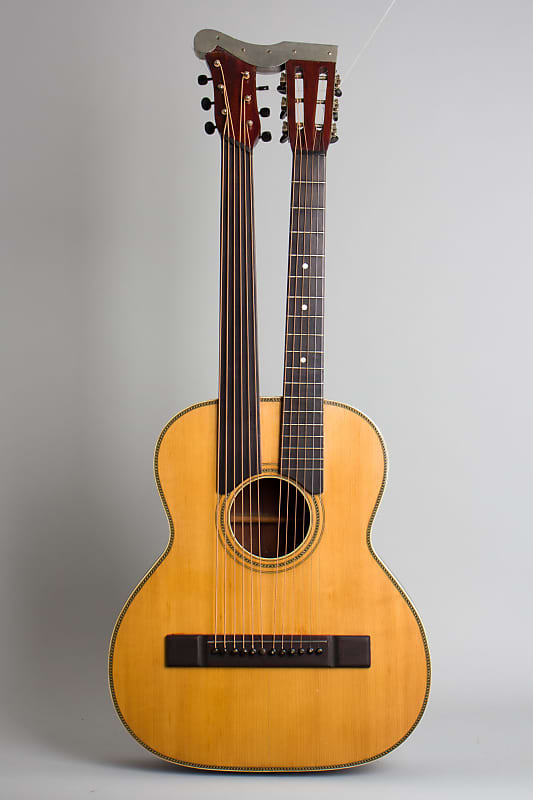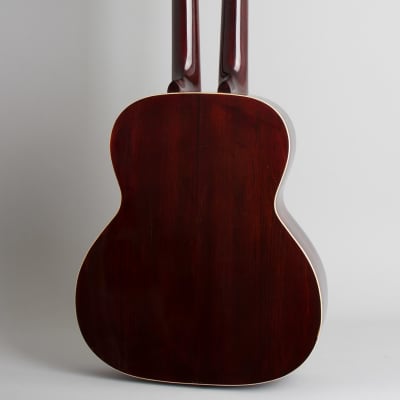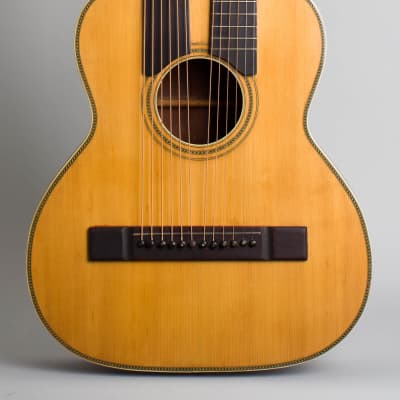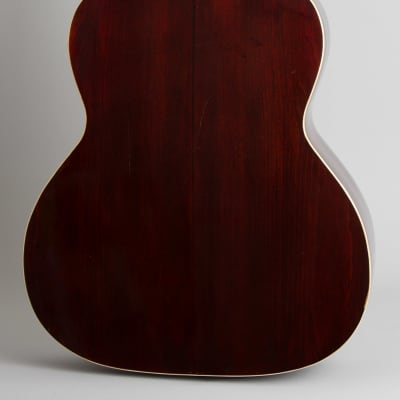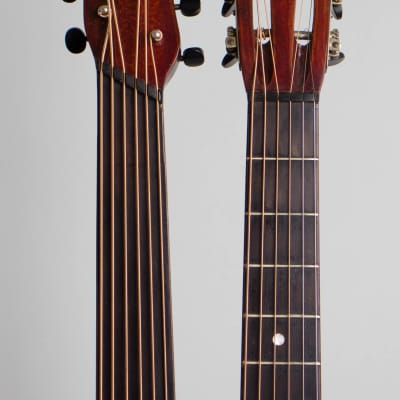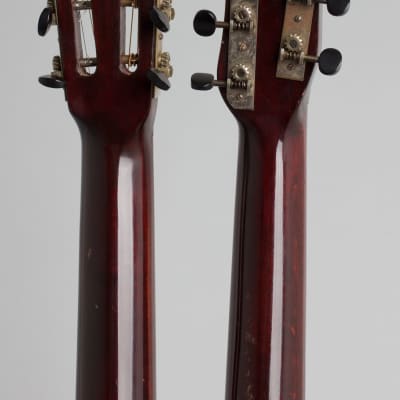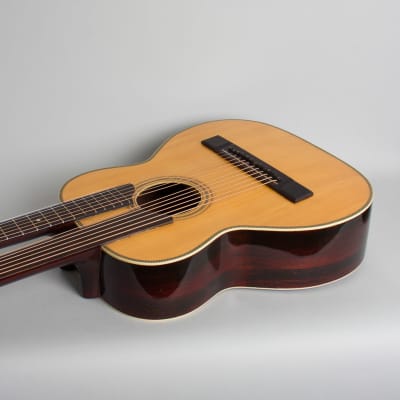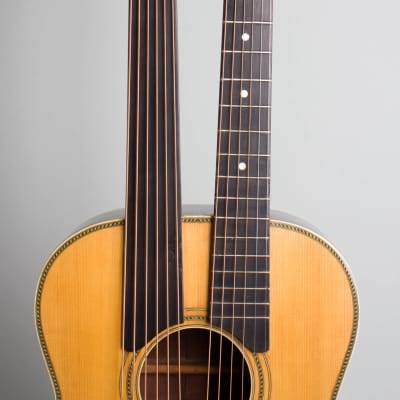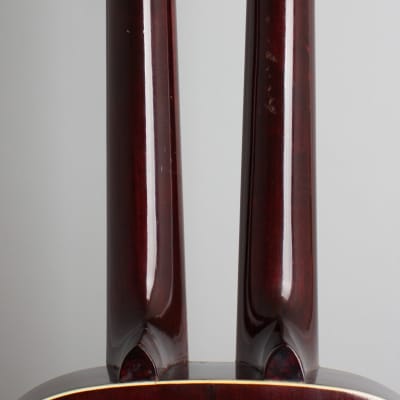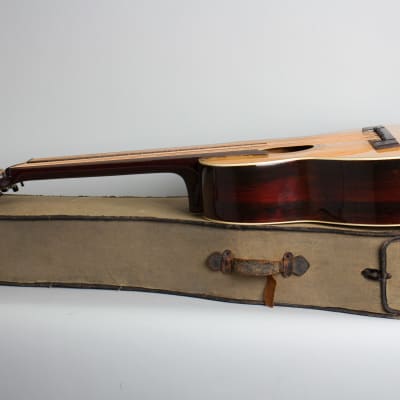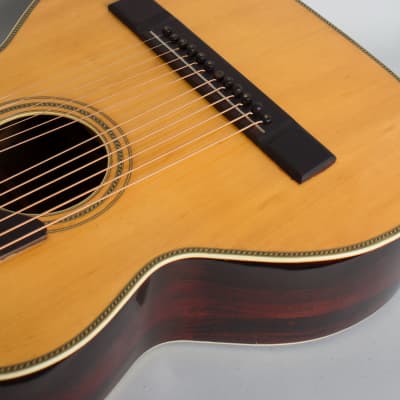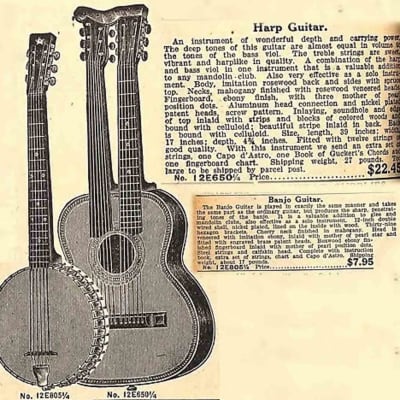Supertone #12E 650 1/4 Model Harp Guitar, most likely made by Harmony, c. 1918, made in Chicago, natural top, faux grained back and sides finish, birch back and sides, spruce top; mahogany necks with ebonized fingerboards, original canvas soft shell case.
If one was perusing the Sears & Roebuck catalog around, say, 1918 and happened to wonder "what is the top of the line, most expensive guitar this merchant would offer?" the answer is you're looking at it here. The full title was the "Model #12E 650 1/4" for reasons known only to Sear's catalogers, and it was a standout piece in their late 1910s Supertone listings. While it's uncertain how many of Sears customers were looking for a double-neck harp guitar, the giant retailer carried it for a few years anyway. The earliest listing offers it for $22.45, while the 1918 catalog price was $29.95 with the canvas case, quite a bit more than any other guitar. This one has lost any label it may have had so may have been originally sold elsewhere, but it is an EXACT match to the known Supertone model.
This imposing guitar is certainly a product of Chicago, most likely made by Harmony (which company Sears had recently purchased) or possibly the Lyon & Healy factory, who had more experience with such things. It is built to a fairly conventional layout (in so much as any double neck acoustic can be called "conventional") with the standard six play strings on a lower fretted neck and six sub-bass strings on an unfretted neck above. Both of these necks have a deep round profile and it is theoretically possible to set up the top neck as a fretless guitar, although the oddly canted nut would make intonation even more challenging than usual! The lower headstock is slotted, while the upper is solid. The headstocks are joined by a decorative metal cap.
The 17" wide body is built of birch or some other indeterminate wood, carefully camouflaged internally with a dark stain and finished externally with a beautifully executed faux rosewood grain which could easily fool the casual observer. The fairly wide-grain spruce top is trimmed with half-herringbone marquetry on the edge and soundhole rim, bound in ivoroid. The bracing is a fairly simple ladder style wit the typical wide flat bridge plate. The instrument is neatly built, and considering its catalog-company origins a fairly high-grade piece.
"An instrument of wonderful depth and power" Sears claimed "a valuable addition to any mandolin club…also very effective as a solo instrument". We have to agree this is a very powerful and fine sounding guitar, even if one ignores the sub-bass strings. It plays very well too, and is a fine survivor of the original harp-guitar era, before fast-moving 20th century music made them mostly redundant.
Overall length is 39 in. (99.1 cm.), 17 in. (43.2 cm.) wide at lower bout, and 4 11/16 in. (11.9 cm.) in depth at side, taken at the end block. Scale length is 25 1/2 in. (648 mm.). Width of nut is 1 11/16 in. (43 mm.).
This large and imposing instrument has survived for something like 105 years showing not a lot of wear but some visible repair work, both older and newer. There is a clear lacquer overspray over the entire instrument that appears to have been done decades ago; the look of the original finish (including the beautiful faux graining) is intact, but the patina is newer. There is only light play wear to this finish. The play neck has been reset more than once; there is a visible seam in the lower neck heel which was a stacked heel from the factory but has been visibly reglued during the neck reset process. There is also some old scarring to the sides of the heels.
The top has an old center seam reglue (under the overfinish) and some smaller grain split repairs in the area of the lower fingerboard/soundhole junction. Considering its size and fairly light construction it is somewhat remarkable that there are no other crack repairs. The top is fitted with an old slightly oversize repro bridge with a wire saddle; this shows a repaired crack through the pins. There are a few small grain pulls repaired off the front edge of this, again under the overspray.
The ladder bracing is original and undisturbed except for an angled brace added on either side of the soundhole to stabilize that otherwise unsupported area of the large top. This very rare instrument plays quite well, is less cumbersome to handle than many of these large harp guitars and has a lovely powerful sound. We have the guitar tuned to D standard where it seems happiest and has a rich resonance, with some sympathetic accents from the sub-bass array. This has been a single-family instrument for over 100 years and still lives in the original WWI era canvas case which is functional for storage anyway. Overall Very Good + Condition.
